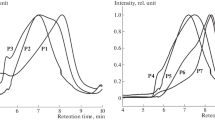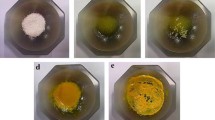Abstract
One polythiophene derivative PT3T and two low band gap copolymers, PBTT-T3T and PBTT, with different ratios of 5,6-dinitrobenzothiadiazole as the acceptor unit in the polymer backbone have been synthesized by Pd-catalyzed Stille-coupling polymerizations. Thermal stability, X-ray diffraction analyses, UV-vis absorption spectra, photoluminescence spectra and electrochemical properties of the copolymers were investigated. The band gap estimated from UV-vis-NIR spectra of the copolymers films varied from 1.39 to 1.94 eV. Among these copolymers, the films of PBTT-T3T and PBTT, which contain the 5,6-dinitrobenzothiadiazole unit, cover a broad wavelength range in the visible and near-infrared region from 400 to 1000 nm with the maximal peak absorption around 700 nm, which is exactly matched with the maximum in the photon flux of the sun.
Similar content being viewed by others
References
Zhang X, Steckler TT, Dasari RR, Ohira S, Potscavage WJ, Tiwari SP, Coppee S, Ellinger S, Barlow S, Bredas JL, Kippelen B, Reynolds JR, Marder SR. Dithienopyrrole-based donor-acceptor copolymers: Low band-gap materials for charge transport, photovoltaics and electrochromism. J Mater Chem, 2010, 20: 123–134
Yao Y, Liang YY, Shrotriya V, Xiao SQ, Yu LP, Yang Y. Plastic near-infrared photodetectors utilizing low band gap polymer. Adv Mater, 2007, 19: 3979–3983
Wienk MM, Turbiez M, Gilot J, Janssen RAJ. Narrow-bandgap diketo-pyrrolo-pyrrole polymer solar cells: The effect of processing on the performance. Adv Mater, 2008, 20: 2556–2560
Thompson BC, Madrigal LG, Pinto MR, Kang TS, Schanze KS, Reynolds JR. Donor-acceotor copolymers for red- and near-infrared-emitting polymer light-emitting diodes. J Polym Sci, Part A: Polym Chem, 2005, 43: 1417–1431
Brabec CJ, Winder C, Sariciftci NS, Hummelen JC, Dhanabalan A, van Hal PA, Janssen RAJ. A low-bandgap semiconducting polymer for photovoltaic devices and infrared emitting diodes. Adv Funct Mater, 2002, 12: 709–712
Qian G, Zhong Z, Luo M, Yu DB, Zhang ZQ, Wang ZY, Ma DG. Simple and efficient near-infrared organic chromophores for light-emitting diodes with single electroluminescent emission above 1000 nm. Adv Mater, 2009, 21: 111–116
Kitamura C, Tanaka S, Yamashita Y. Design of narrow-bandgap polymers. Syntheses and properties of monomers and polymers containing aromatic-donor and o-quinoid-acceptor units. Chem Mater, 1996, 8: 570–578
Winder C, Sariciftci NS. Low bandgap polymers for photon harvesting in bulk heterojunction solar cells. J Mater Chem, 2004, 14: 1077–1086
Colladet K, Fourier S, Cleij TJ, Lutsen L, Gelan J, Vanderzande D, Nguyen LH, Neugebauer H, Sariciftci S, Aguirre A, Janssen G, Goovaerts E. Low band gap donor-acceptor conjugated polymers toward organic solar cells applications. Macromolecules, 2007, 40: 65–72
Blouin N, Michaud A, Leclerc M. A low-bandgap poly(2,7-carbazole) derivative for use in high-performance solar cells. Adv Mater, 2007, 19: 2295–2300
Yue W, Zhao Y, Shao SY, Tian HK, Xie ZY, Geng YH, Wang FS. Novel NIR-absorbing conjugated polymers for efficient polymer solar cells: effect of alkyl chain length on device performance. J Mater Chem, 2009, 19: 2199–2206
Park SH, Roy A, Beaupre S, Cho S, Coates N, Moon JS, Moses D, Leclerc M, Lee K, Heeger AJ. Bulk heterojunction solar cells with internal quantum efficiency approaching 100%. Nat Photonics, 2009, 3: 297–303
Chen JW, Cao Y. Development of novel conjugated donor polymers for high-efficiency bulk-heterojunction photovoltaic devices. Acc Chem Res, 2009, 42: 1709–1718
Chen CH, Hsieh CH, Dubosc M, Cheng YJ, Su CS. Synthesis and characterization of bridged bithiophene-based conjugated polymers for photovoltaic applications: Acceptor strength and ternary blends. Macromolecules, 2010, 43: 697–708
He YJ, Wang X, Zhang J, Li YF. Low bandgap polymers by copolymerization of thiophene with benzothiadiazole. Macromol Rapid Commun, 2009, 30: 45–51
Perzon E, Wang XJ, Admassie S, Inganas O, Andersson MR. An alternating low band-gap polyfluorene for optoelectronic devices. Polymer, 2006, 47: 4261–4268
Voituriez A, Mellah M, Schulz E. Design and electropolymerization of new chiral thiophene-salen complexes. Synth Met, 2006, 156: 166–175
Liu YS, Zhou JY, Wan XJ, Chen YS. Synthesis and properties of acceptor-donor-acceptor molecules based on oligothiophenes with tunable and low band gap. Tetrahedron, 2009, 65: 5209–5215
Van Pham C, Macomber RS, Mark HB, Jr Zimmer H. Lithiation reaction of 2,5-dibromothiophene. Carbon-13 NMR spectra of 3-substituted derivatives. J Org Chem, 1984, 49: 5250–5253
Blouin N, Michaud A, Gendron D, Wakim S, Blair E, Neagu-Plesu R, Belletete M, Durocher G, Tao Y, Leclerc M. Toward a rational design of poly(2,7-carbazole) derivatives for solar cells. J Am Chem Soc, 2007, 130: 732–742
Samitsu S, Shimomura T, Heike S, Hashizume T, Ito K. Effective production of poly(3-alkylthiophene) nanofibers by means of Whisker method using anisole solvent: Structural, optical, and electrical properties. Macromolecules, 2008, 41: 8000–8010
Shrotriya V, Ouyang J, Tseng RJ, Li G, Yang Y. Absorption spectra modification in poly(3-hexylthiophene): Methanofullerene blend thin films. Chem Phys Lett, 2005, 411: 138–143
Li LG, Tang HW, Wu HX, Lu GH, Yang XN. Effects of fullerene solubility on the crystallization of poly(3-hexylthiophene) and performance of photovoltaic devices. Org Electron, 2009, 10: 1334–1344
Biniek L, Chochos CL, Leclerc N, Hadziioannou G, Kallitsis JK, Bechara R, Leveque P, Heiser T. A [3,2-b]thienothiophene-alt-benzothiadiazole copolymer for photovoltaic applications: Design, synthesis, material characterization and device performances. J Mater Chem, 2009, 19: 4946–4951
Cao J, Kampf JW, Curtis MD. Synthesis and characterization of bis (3,4-ethylene-dioxythiophene)-(4,4′-dialkyl-2,2′-bithiazole) co-oligomers for electronic applications. Chem Mater, 2003, 15: 404–411
Kim JY, Lee K, Coates NE, Moses D, Nguyen TQ, Dante M, Heeger AJ. Efficient tandem polymer solar cells fabricated by all-solution processing. Science, 2007, 317: 222–225
Li K, Qu JL, Xu B, Zhou YH, Liu LJ, Peng P, Tian WJ. Synthesis and photovoltaic properties of novel solution-processable triphenylamine-based dendrimers with sulfonyldibenzene cores. New J Chem, 2009, 33: 2120–2127
Hellstrom S, Zhang FL, Inganas O, Andersson MR. Structure-property relationships of small bandgap conjugated polymers for solar cells. Dalton Trans, 2009, 45: 10032–10039
Holcombe TW, Woo CH, Kavulak DFJ, Thompson BC, Frechet JMJ. All-polymer photovoltaic devices of poly(3-(4-n-octyl)-phenylthiophene) from Grignard Metathesis (GRIM) polymerization. J Am Chem Soc, 2009, 131: 14160–14161
Koetse MM, Sweelssen J, Hoekerd KT, Schoo HFM, Veenstra SC, Kroon JM, Yang XN, Loos J. Efficient polymer: Polymer bulk heterojunction solar cells. Appl Phys Lett, 2006, 88: 083504
Sang GY, Zou YP, Huang Y, Zhao GJ, Yang Y, Li YF. All-polymer solar cells based on a blend of poly[3-(10-n-octyl-3-phenothiazinevinylene)thiophene-co-2,5-thiophene] and poly[1,4-dioctyloxyl-p-2,5-dicyanophenylenevinylene]. Appl Phys Lett, 2009, 94: 193302
Xia YJ, Luo J, Deng XY, Li XZ, Li DY, Zhu XH, Yang W, Cao Y. Novel random low-band-gap fluorene-based copolymers for deep red/near infrared light-emitting diodes and bulk heterojunction photovoltaic cells. Macromol Chem Phys, 2006, 207: 511–520
Samuel IDW, Rumbles G, Collison CJ. Efficient interchain photoluminescence in a high-electron-affinity conjugated polymer. Phys Rev B, 1995, 52: 11573–11576
Author information
Authors and Affiliations
Corresponding author
Electronic supplementary material
Rights and permissions
About this article
Cite this article
Wang, F., Liu, Y., Wan, X. et al. Synthesis and properties of copolymers based on 5,6-dinitrobenzothiadiazole with low band gap and broad absorption spectra. Sci. China Chem. 54, 617–624 (2011). https://doi.org/10.1007/s11426-011-4244-8
Received:
Accepted:
Published:
Issue Date:
DOI: https://doi.org/10.1007/s11426-011-4244-8




